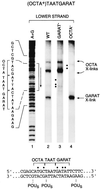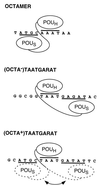Structural flexibility in transcription complex formation revealed by protein-DNA photocrosslinking
- PMID: 9237997
- PMCID: PMC22952
- DOI: 10.1073/pnas.94.16.8450
Structural flexibility in transcription complex formation revealed by protein-DNA photocrosslinking
Abstract
The Oct-1 POU domain binds diverse DNA-sequence elements and forms a higher-order regulatory complex with the herpes simplex virus coregulator VP16. The POU domain contains two separate DNA-binding domains joined by a flexible linker. By protein-DNA photocrosslinking we show that the relative positioning of the two POU DNA-binding domains on DNA varies depending on the nature of the DNA target. On a single VP16-responsive element, the POU domain adopts multiple conformations. To determine the structure of the Oct-1 POU domain in a multiprotein complex with VP16, we allowed VP16 to interact with previously crosslinked POU-domain-DNA complexes and found that VP16 can associate with multiple POU-domain conformations. These results reveal the dynamic potential of a DNA-binding domain in directing transcriptional regulatory complex formation.
Figures






Similar articles
-
OCA-B is a functional analog of VP16 but targets a separate surface of the Oct-1 POU domain.Mol Cell Biol. 1997 Dec;17(12):7295-305. doi: 10.1128/MCB.17.12.7295. Mol Cell Biol. 1997. PMID: 9372961 Free PMC article.
-
Mechanisms for flexibility in DNA sequence recognition and VP16-induced complex formation by the Oct-1 POU domain.Mol Cell Biol. 1995 Apr;15(4):2090-100. doi: 10.1128/MCB.15.4.2090. Mol Cell Biol. 1995. PMID: 7891704 Free PMC article.
-
Site-specific conformational alteration of the Oct-1 POU domain-DNA complex as the basis for differential recognition by Vmw65 (VP16).Cell. 1994 Dec 2;79(5):841-52. doi: 10.1016/0092-8674(94)90073-6. Cell. 1994. PMID: 8001121
-
The POU domain: versatility in transcriptional regulation by a flexible two-in-one DNA-binding domain.Genes Dev. 1995 Jul 15;9(14):1679-93. doi: 10.1101/gad.9.14.1679. Genes Dev. 1995. PMID: 7622033 Review. No abstract available.
-
POU domain factors in neural development.Adv Exp Med Biol. 1998;449:39-53. doi: 10.1007/978-1-4615-4871-3_4. Adv Exp Med Biol. 1998. PMID: 10026784 Review.
Cited by
-
Loss-of-function, gain-of-function and dominant-negative mutations have profoundly different effects on protein structure.Nat Commun. 2022 Jul 6;13(1):3895. doi: 10.1038/s41467-022-31686-6. Nat Commun. 2022. PMID: 35794153 Free PMC article.
-
DNA recognition by the herpes simplex virus transactivator VP16: a novel DNA-binding structure.Mol Cell Biol. 2001 Jul;21(14):4700-12. doi: 10.1128/MCB.21.14.4700-4712.2001. Mol Cell Biol. 2001. PMID: 11416146 Free PMC article.
-
OCA-B is a functional analog of VP16 but targets a separate surface of the Oct-1 POU domain.Mol Cell Biol. 1997 Dec;17(12):7295-305. doi: 10.1128/MCB.17.12.7295. Mol Cell Biol. 1997. PMID: 9372961 Free PMC article.
-
Lithographic patterning of photoreactive cell-adhesive proteins.J Am Chem Soc. 2007 Apr 25;129(16):4874-5. doi: 10.1021/ja070200b. Epub 2007 Mar 31. J Am Chem Soc. 2007. PMID: 17397163 Free PMC article. No abstract available.
-
The glucocorticoid receptor blocks P-TEFb recruitment by NFkappaB to effect promoter-specific transcriptional repression.Genes Dev. 2005 May 1;19(9):1116-27. doi: 10.1101/gad.1297105. Genes Dev. 2005. PMID: 15879558 Free PMC article.
References
-
- Herr W, Sturm R A, Clerc R G, Corcoran L M, Baltimore D, Sharp P A, Ingraham H A, Rosenfeld M G, Finney M, Ruvkun G, Horvitz H R. Genes Dev. 1988;2:1513–1516. - PubMed
-
- Klemm J D, Rould M A, Aurora R, Herr W, Pabo C O. Cell. 1994;77:21–32. - PubMed
-
- Jacobson E M, Li P, Leon-del-Rio A, Rosenfeld M G, Aggarwal A K. Genes Dev. 1997;11:198–212. - PubMed
-
- Herr W, Cleary M A. Genes Dev. 1995;9:1679–1693. - PubMed
-
- Li P, He X, Gerrero M R, Mok M, Aggarwal A, Rosenfeld M G. Genes Dev. 1993;7:2483–2496. - PubMed
Publication types
MeSH terms
Substances
Grants and funding
LinkOut - more resources
Full Text Sources

